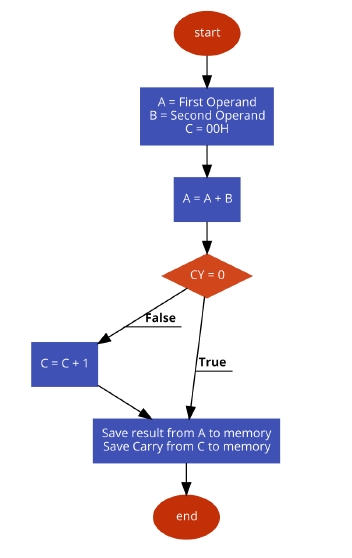
 Data Structure
Data Structure Networking
Networking RDBMS
RDBMS Operating System
Operating System Java
Java MS Excel
MS Excel iOS
iOS HTML
HTML CSS
CSS Android
Android Python
Python C Programming
C Programming C++
C++ C#
C# MongoDB
MongoDB MySQL
MySQL Javascript
Javascript PHP
PHP
- Selected Reading
- UPSC IAS Exams Notes
- Developer's Best Practices
- Questions and Answers
- Effective Resume Writing
- HR Interview Questions
- Computer Glossary
- Who is Who
8085 program to subtract two 8-bit numbers with or without borrow
In this program we will see how to subtract two 8-bit numbers using 8085 microprocessor.
Problem Statement
Write 8085 Assembly language program to subtract two 8-bit numbers with or without borrow and store the result at locations 8050H and 8051H.
Discussion
In 8085, the SUB instruction is used 2’s complemented method for subtraction. When the first operand is larger, the result will be positive. It will not enable the carry flag after completing the subtraction. When the result is negative, then the result will be in 2’s complemented form and carry flag will be enabled.
We are using two numbers at location 8000H and 8001H. When the numbers are 78H and 5DH, then the result will be (78 – 5D = 1B) and when the numbers are 23H and CFH, then the result will be (23 – CF = 154) Here 1 indicates the number is negative. The actual result is 54H. It is in 2’s complemented form.
Input
first output
| Address | Data |
|---|---|
| . . . |
. . . |
| 8000 | 78 |
| 8001 | 5D |
| . . . |
. . . |
second output
| Address | Data |
|---|---|
| . . . |
. . . |
| 8000 | 23 |
| 8001 | CF |
| . . . |
. . . |
Flow Diagram

| Address | HEXCodes | Labels | Mnemonics | Comments |
|---|---|---|---|---|
| F000 | 0E, 00 | MVI C,00H | Clear C register | |
| F002 | 21, 00, 80 | LXI H,8000H | Load initial address to get operand | |
| F005 | 7E | MOV A,M | Load Acc with memory element | |
| F006 | 23 | INX H | Point to next location | |
| F007 | 46 | MOV B, M | Load B with second operand | |
| F008 | 90 | SUB B | Subtract B from A | |
| F009 | D2, 0D, F0 | JNC STORE | When CY = 0, go to STORE | |
| F00C | 0C | INR C | Increase C by 1 | |
| F00D | 21, 50, 80 | STORE | LXI H,8050H | Load the destination address |
| F010 | 77 | MOV M, A | Store the result | |
| F011 | 23 | INX H | Point to next location | |
| F012 | 71 | MOV M, C | Store the borrow | |
| F013 | 76 | HLT | Terminate the program |
Output
first output
| Address | Data |
|---|---|
| . . . |
. . . |
| 8050 | 1B |
| 8051 | 00 |
| . . . |
. . . |
second output
| Address | Data |
|---|---|
| . . . |
. . . |
| 8050 | 54 |
| 8051 | 01 |
| . . . |
. . . |

